ECON 5308: Retail Market Dynamics and AI in Decision Making
VerifiedAdded on 2023/01/17
|16
|4110
|20
Essay
AI Summary
This essay, prepared for ECON 5308, examines the evolving landscape of the retail market. The first part analyzes the factors contributing to the decline of traditional brick-and-mortar stores, including demographic, socio-economic, lifestyle, and behavioral influences, while also offering potential marketing and economic strategies for these stores to adapt and remain competitive. The second part delves into the pervasive role of Artificial Intelligence (AI) in modern society, discussing its applications and benefits from a managerial perspective, including its impact on various sectors like manufacturing, service, and consumer products, along with the challenges associated with its implementation.

Running head: ECONOMICS
Economics
Name of the student
Name if the university
Author note
Economics
Name of the student
Name if the university
Author note
Paraphrase This Document
Need a fresh take? Get an instant paraphrase of this document with our AI Paraphraser
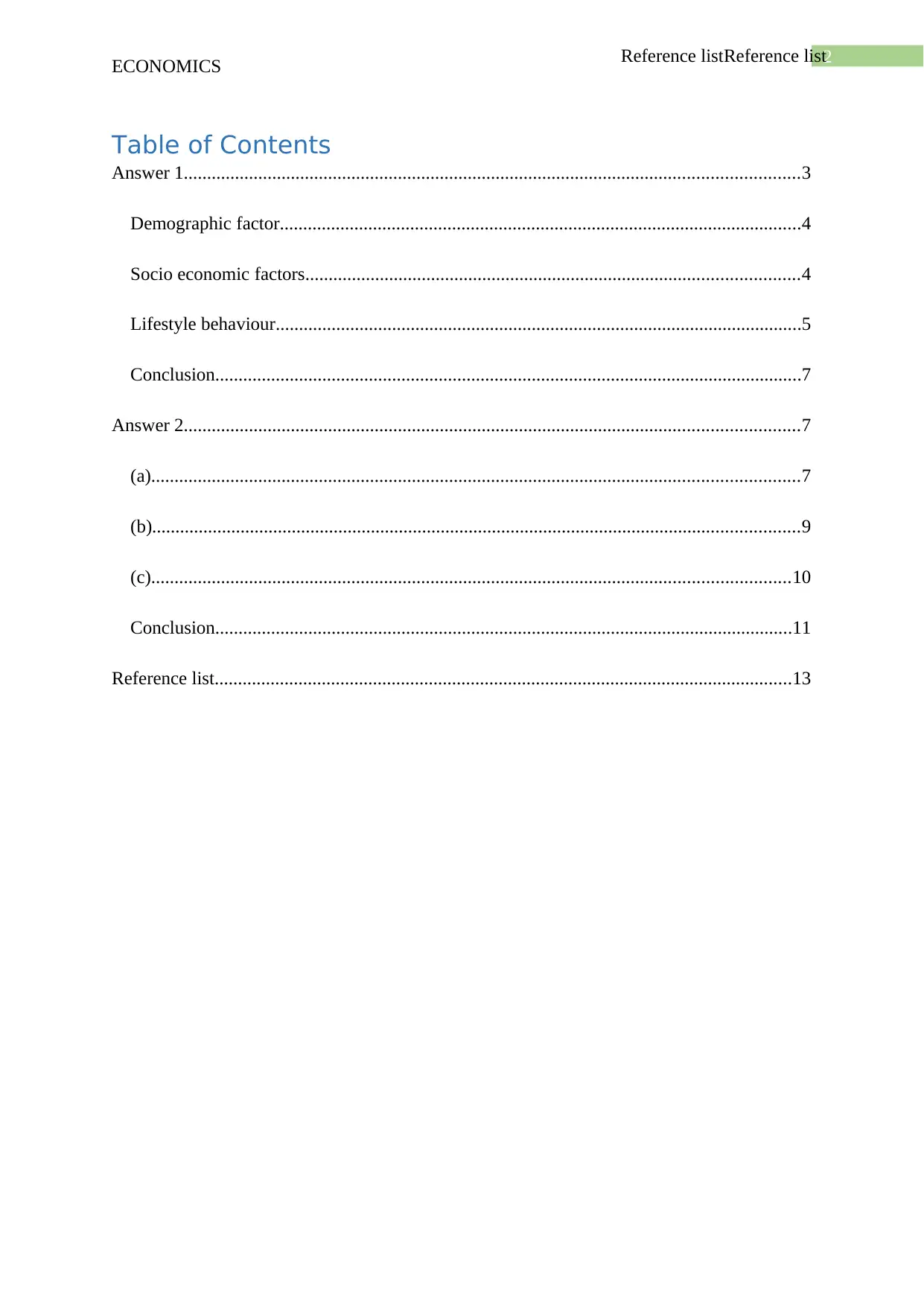
2Reference listReference list
ECONOMICS
Table of Contents
Answer 1....................................................................................................................................3
Demographic factor................................................................................................................4
Socio economic factors..........................................................................................................4
Lifestyle behaviour.................................................................................................................5
Conclusion..............................................................................................................................7
Answer 2....................................................................................................................................7
(a)...........................................................................................................................................7
(b)...........................................................................................................................................9
(c).........................................................................................................................................10
Conclusion............................................................................................................................11
Reference list............................................................................................................................13
ECONOMICS
Table of Contents
Answer 1....................................................................................................................................3
Demographic factor................................................................................................................4
Socio economic factors..........................................................................................................4
Lifestyle behaviour.................................................................................................................5
Conclusion..............................................................................................................................7
Answer 2....................................................................................................................................7
(a)...........................................................................................................................................7
(b)...........................................................................................................................................9
(c).........................................................................................................................................10
Conclusion............................................................................................................................11
Reference list............................................................................................................................13
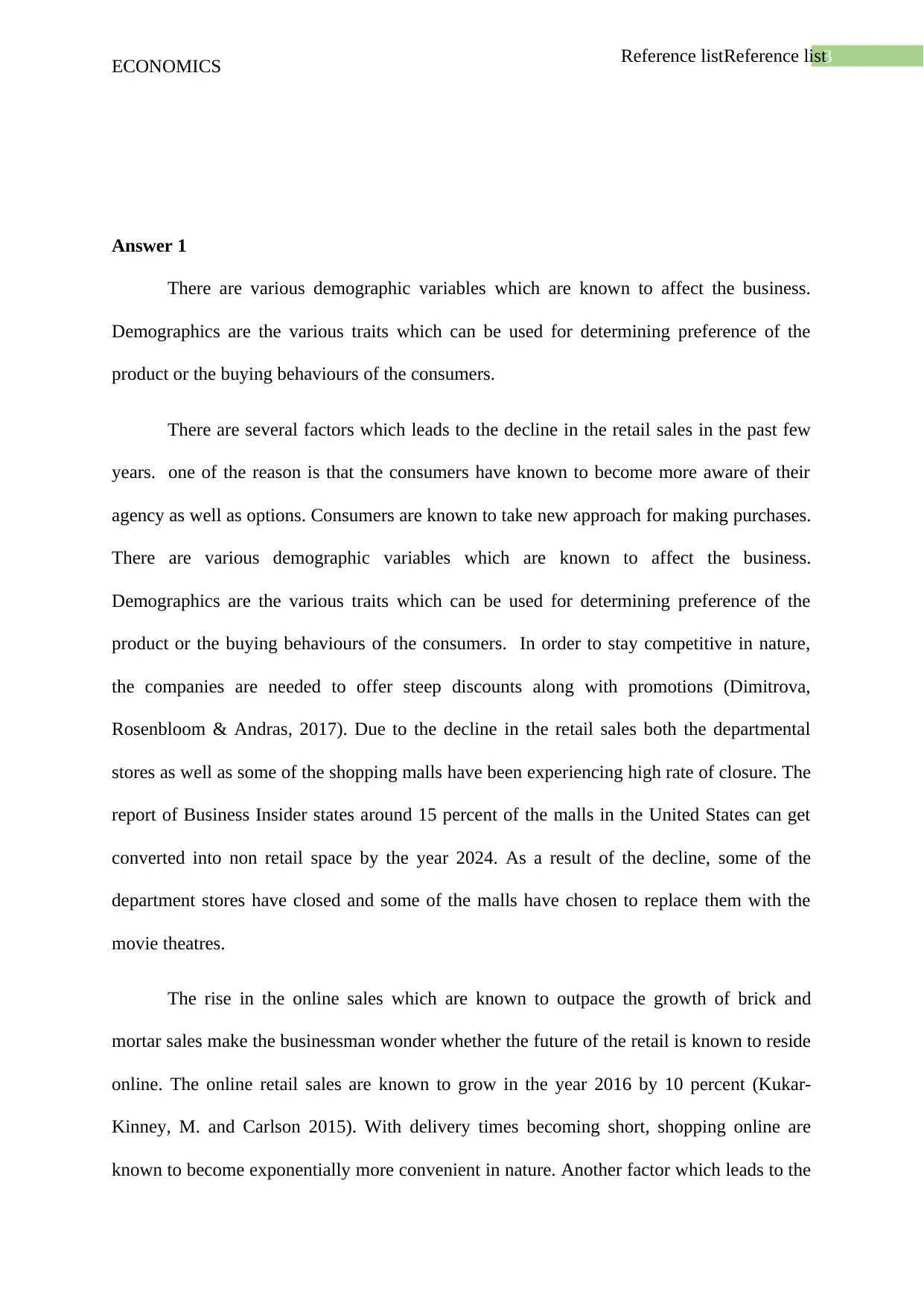
3Reference listReference list
ECONOMICS
Answer 1
There are various demographic variables which are known to affect the business.
Demographics are the various traits which can be used for determining preference of the
product or the buying behaviours of the consumers.
There are several factors which leads to the decline in the retail sales in the past few
years. one of the reason is that the consumers have known to become more aware of their
agency as well as options. Consumers are known to take new approach for making purchases.
There are various demographic variables which are known to affect the business.
Demographics are the various traits which can be used for determining preference of the
product or the buying behaviours of the consumers. In order to stay competitive in nature,
the companies are needed to offer steep discounts along with promotions (Dimitrova,
Rosenbloom & Andras, 2017). Due to the decline in the retail sales both the departmental
stores as well as some of the shopping malls have been experiencing high rate of closure. The
report of Business Insider states around 15 percent of the malls in the United States can get
converted into non retail space by the year 2024. As a result of the decline, some of the
department stores have closed and some of the malls have chosen to replace them with the
movie theatres.
The rise in the online sales which are known to outpace the growth of brick and
mortar sales make the businessman wonder whether the future of the retail is known to reside
online. The online retail sales are known to grow in the year 2016 by 10 percent (Kukar-
Kinney, M. and Carlson 2015). With delivery times becoming short, shopping online are
known to become exponentially more convenient in nature. Another factor which leads to the
ECONOMICS
Answer 1
There are various demographic variables which are known to affect the business.
Demographics are the various traits which can be used for determining preference of the
product or the buying behaviours of the consumers.
There are several factors which leads to the decline in the retail sales in the past few
years. one of the reason is that the consumers have known to become more aware of their
agency as well as options. Consumers are known to take new approach for making purchases.
There are various demographic variables which are known to affect the business.
Demographics are the various traits which can be used for determining preference of the
product or the buying behaviours of the consumers. In order to stay competitive in nature,
the companies are needed to offer steep discounts along with promotions (Dimitrova,
Rosenbloom & Andras, 2017). Due to the decline in the retail sales both the departmental
stores as well as some of the shopping malls have been experiencing high rate of closure. The
report of Business Insider states around 15 percent of the malls in the United States can get
converted into non retail space by the year 2024. As a result of the decline, some of the
department stores have closed and some of the malls have chosen to replace them with the
movie theatres.
The rise in the online sales which are known to outpace the growth of brick and
mortar sales make the businessman wonder whether the future of the retail is known to reside
online. The online retail sales are known to grow in the year 2016 by 10 percent (Kukar-
Kinney, M. and Carlson 2015). With delivery times becoming short, shopping online are
known to become exponentially more convenient in nature. Another factor which leads to the
⊘ This is a preview!⊘
Do you want full access?
Subscribe today to unlock all pages.

Trusted by 1+ million students worldwide
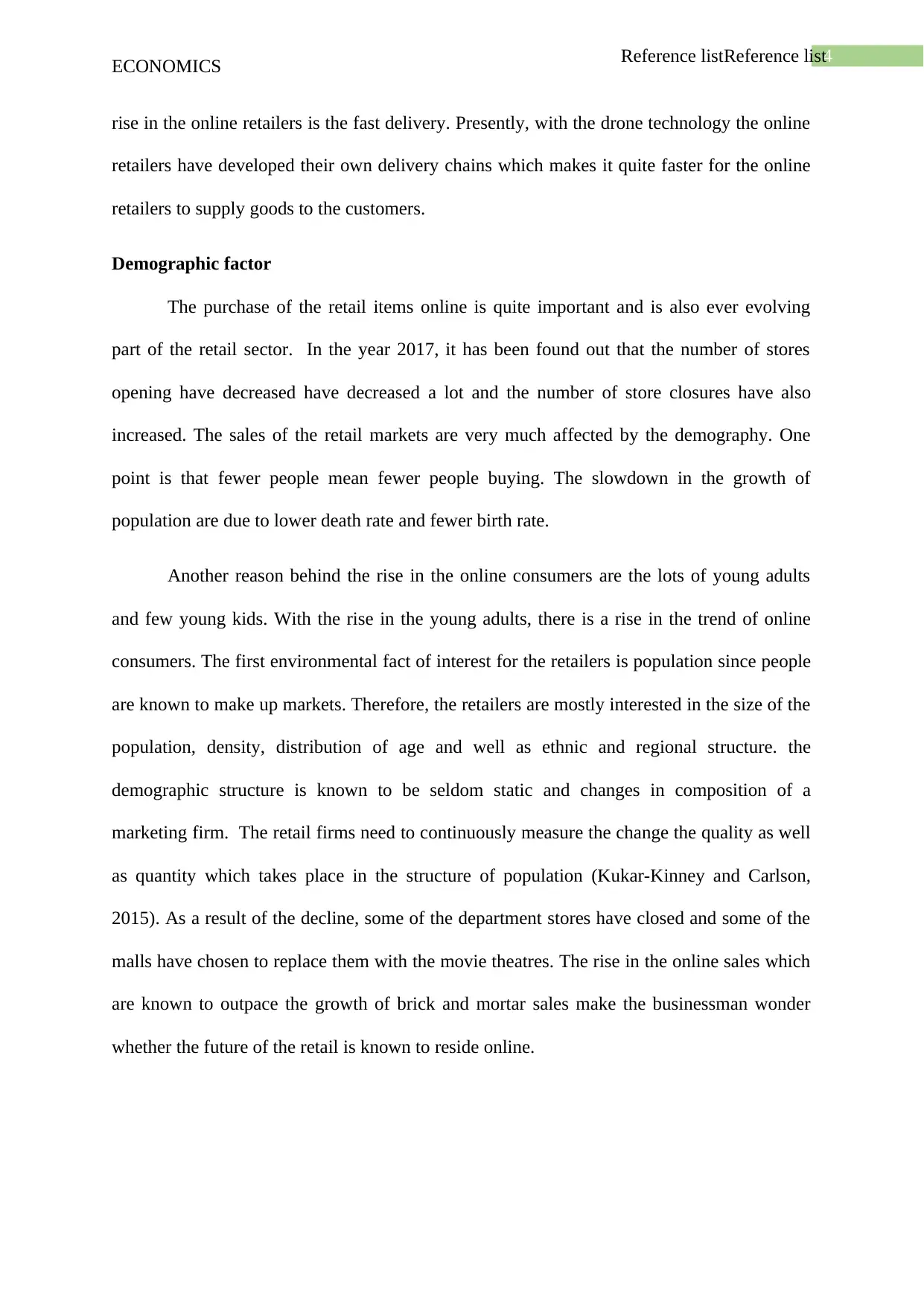
4Reference listReference list
ECONOMICS
rise in the online retailers is the fast delivery. Presently, with the drone technology the online
retailers have developed their own delivery chains which makes it quite faster for the online
retailers to supply goods to the customers.
Demographic factor
The purchase of the retail items online is quite important and is also ever evolving
part of the retail sector. In the year 2017, it has been found out that the number of stores
opening have decreased have decreased a lot and the number of store closures have also
increased. The sales of the retail markets are very much affected by the demography. One
point is that fewer people mean fewer people buying. The slowdown in the growth of
population are due to lower death rate and fewer birth rate.
Another reason behind the rise in the online consumers are the lots of young adults
and few young kids. With the rise in the young adults, there is a rise in the trend of online
consumers. The first environmental fact of interest for the retailers is population since people
are known to make up markets. Therefore, the retailers are mostly interested in the size of the
population, density, distribution of age and well as ethnic and regional structure. the
demographic structure is known to be seldom static and changes in composition of a
marketing firm. The retail firms need to continuously measure the change the quality as well
as quantity which takes place in the structure of population (Kukar-Kinney and Carlson,
2015). As a result of the decline, some of the department stores have closed and some of the
malls have chosen to replace them with the movie theatres. The rise in the online sales which
are known to outpace the growth of brick and mortar sales make the businessman wonder
whether the future of the retail is known to reside online.
ECONOMICS
rise in the online retailers is the fast delivery. Presently, with the drone technology the online
retailers have developed their own delivery chains which makes it quite faster for the online
retailers to supply goods to the customers.
Demographic factor
The purchase of the retail items online is quite important and is also ever evolving
part of the retail sector. In the year 2017, it has been found out that the number of stores
opening have decreased have decreased a lot and the number of store closures have also
increased. The sales of the retail markets are very much affected by the demography. One
point is that fewer people mean fewer people buying. The slowdown in the growth of
population are due to lower death rate and fewer birth rate.
Another reason behind the rise in the online consumers are the lots of young adults
and few young kids. With the rise in the young adults, there is a rise in the trend of online
consumers. The first environmental fact of interest for the retailers is population since people
are known to make up markets. Therefore, the retailers are mostly interested in the size of the
population, density, distribution of age and well as ethnic and regional structure. the
demographic structure is known to be seldom static and changes in composition of a
marketing firm. The retail firms need to continuously measure the change the quality as well
as quantity which takes place in the structure of population (Kukar-Kinney and Carlson,
2015). As a result of the decline, some of the department stores have closed and some of the
malls have chosen to replace them with the movie theatres. The rise in the online sales which
are known to outpace the growth of brick and mortar sales make the businessman wonder
whether the future of the retail is known to reside online.
Paraphrase This Document
Need a fresh take? Get an instant paraphrase of this document with our AI Paraphraser
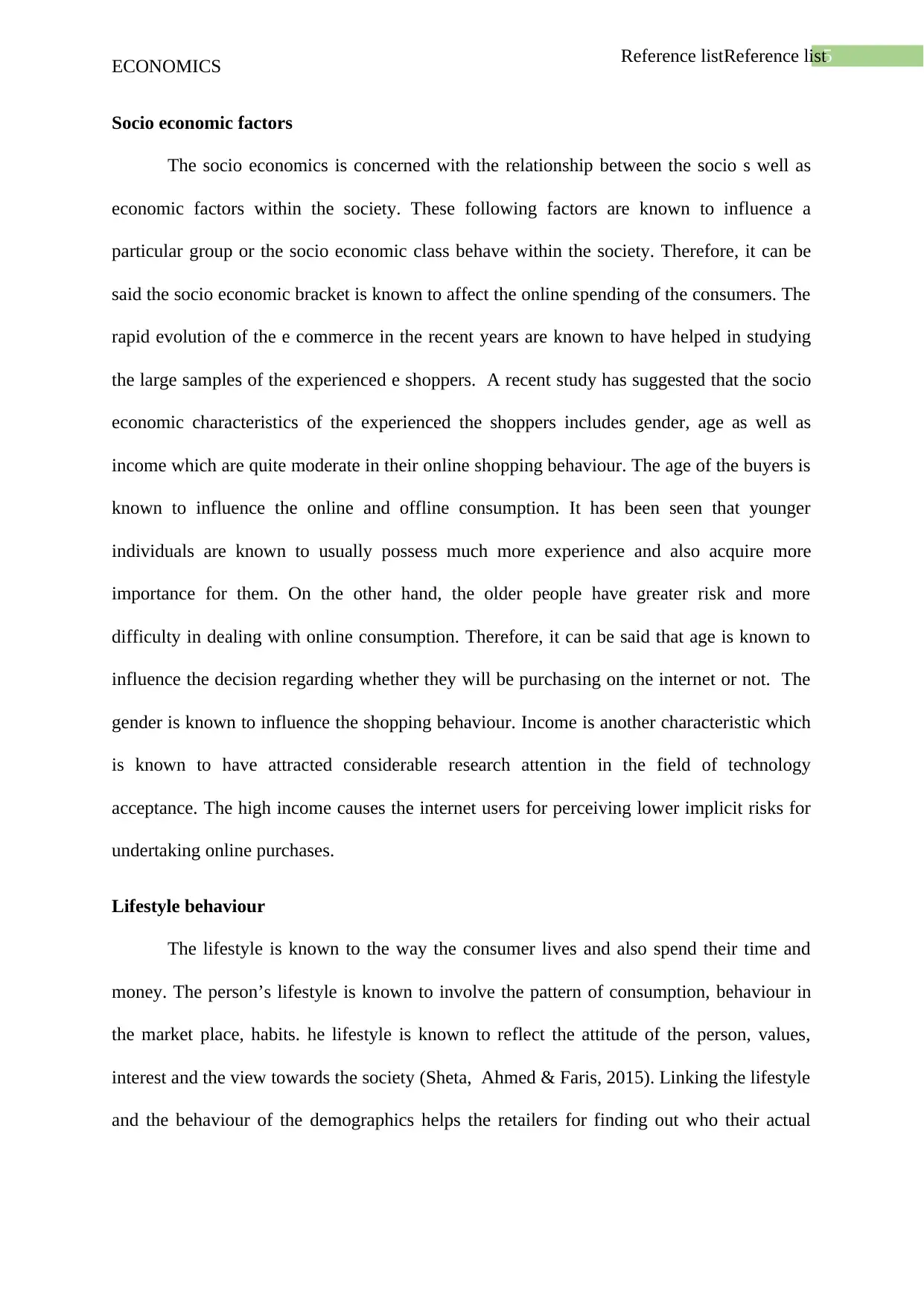
5Reference listReference list
ECONOMICS
Socio economic factors
The socio economics is concerned with the relationship between the socio s well as
economic factors within the society. These following factors are known to influence a
particular group or the socio economic class behave within the society. Therefore, it can be
said the socio economic bracket is known to affect the online spending of the consumers. The
rapid evolution of the e commerce in the recent years are known to have helped in studying
the large samples of the experienced e shoppers. A recent study has suggested that the socio
economic characteristics of the experienced the shoppers includes gender, age as well as
income which are quite moderate in their online shopping behaviour. The age of the buyers is
known to influence the online and offline consumption. It has been seen that younger
individuals are known to usually possess much more experience and also acquire more
importance for them. On the other hand, the older people have greater risk and more
difficulty in dealing with online consumption. Therefore, it can be said that age is known to
influence the decision regarding whether they will be purchasing on the internet or not. The
gender is known to influence the shopping behaviour. Income is another characteristic which
is known to have attracted considerable research attention in the field of technology
acceptance. The high income causes the internet users for perceiving lower implicit risks for
undertaking online purchases.
Lifestyle behaviour
The lifestyle is known to the way the consumer lives and also spend their time and
money. The person’s lifestyle is known to involve the pattern of consumption, behaviour in
the market place, habits. he lifestyle is known to reflect the attitude of the person, values,
interest and the view towards the society (Sheta, Ahmed & Faris, 2015). Linking the lifestyle
and the behaviour of the demographics helps the retailers for finding out who their actual
ECONOMICS
Socio economic factors
The socio economics is concerned with the relationship between the socio s well as
economic factors within the society. These following factors are known to influence a
particular group or the socio economic class behave within the society. Therefore, it can be
said the socio economic bracket is known to affect the online spending of the consumers. The
rapid evolution of the e commerce in the recent years are known to have helped in studying
the large samples of the experienced e shoppers. A recent study has suggested that the socio
economic characteristics of the experienced the shoppers includes gender, age as well as
income which are quite moderate in their online shopping behaviour. The age of the buyers is
known to influence the online and offline consumption. It has been seen that younger
individuals are known to usually possess much more experience and also acquire more
importance for them. On the other hand, the older people have greater risk and more
difficulty in dealing with online consumption. Therefore, it can be said that age is known to
influence the decision regarding whether they will be purchasing on the internet or not. The
gender is known to influence the shopping behaviour. Income is another characteristic which
is known to have attracted considerable research attention in the field of technology
acceptance. The high income causes the internet users for perceiving lower implicit risks for
undertaking online purchases.
Lifestyle behaviour
The lifestyle is known to the way the consumer lives and also spend their time and
money. The person’s lifestyle is known to involve the pattern of consumption, behaviour in
the market place, habits. he lifestyle is known to reflect the attitude of the person, values,
interest and the view towards the society (Sheta, Ahmed & Faris, 2015). Linking the lifestyle
and the behaviour of the demographics helps the retailers for finding out who their actual
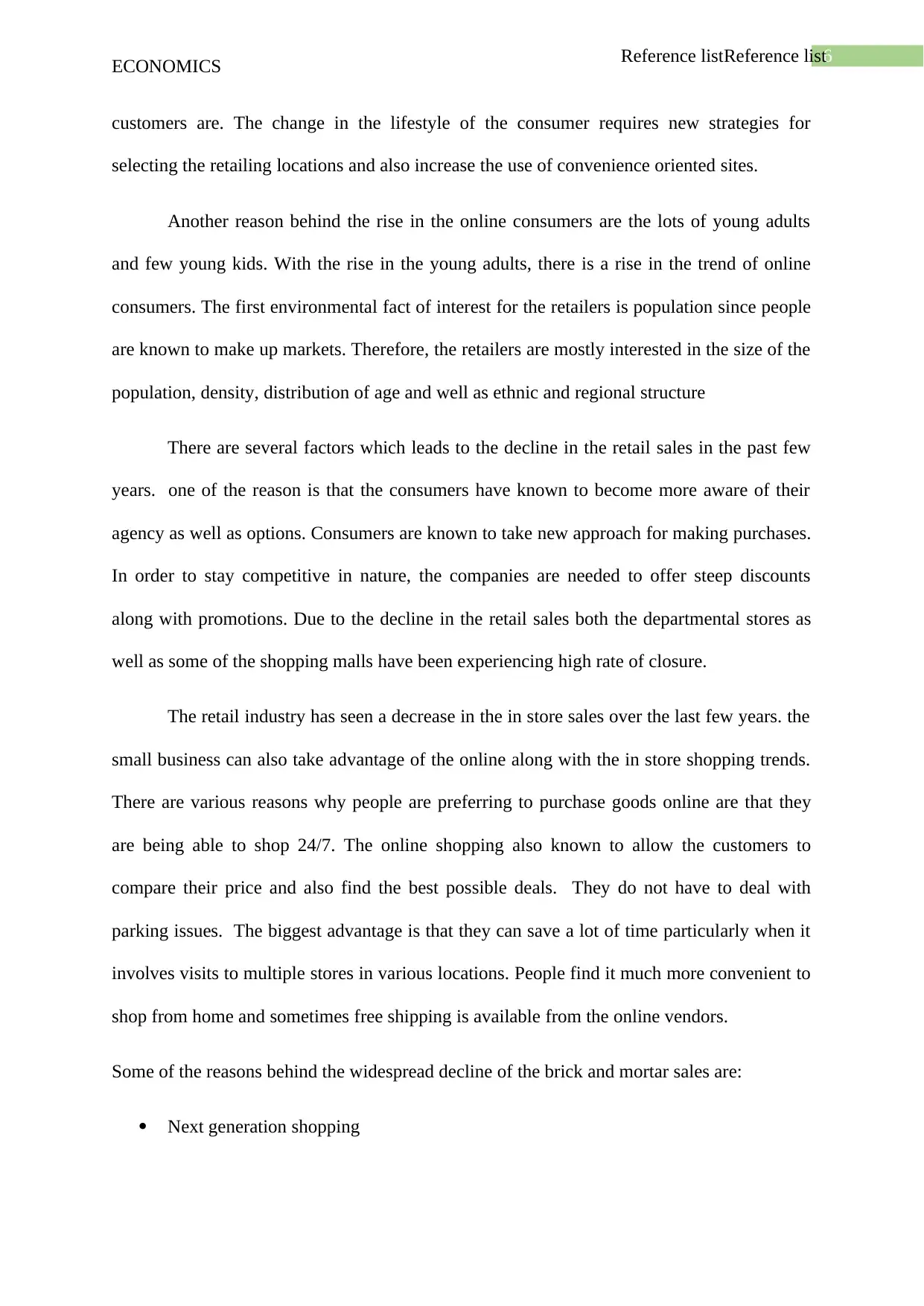
6Reference listReference list
ECONOMICS
customers are. The change in the lifestyle of the consumer requires new strategies for
selecting the retailing locations and also increase the use of convenience oriented sites.
Another reason behind the rise in the online consumers are the lots of young adults
and few young kids. With the rise in the young adults, there is a rise in the trend of online
consumers. The first environmental fact of interest for the retailers is population since people
are known to make up markets. Therefore, the retailers are mostly interested in the size of the
population, density, distribution of age and well as ethnic and regional structure
There are several factors which leads to the decline in the retail sales in the past few
years. one of the reason is that the consumers have known to become more aware of their
agency as well as options. Consumers are known to take new approach for making purchases.
In order to stay competitive in nature, the companies are needed to offer steep discounts
along with promotions. Due to the decline in the retail sales both the departmental stores as
well as some of the shopping malls have been experiencing high rate of closure.
The retail industry has seen a decrease in the in store sales over the last few years. the
small business can also take advantage of the online along with the in store shopping trends.
There are various reasons why people are preferring to purchase goods online are that they
are being able to shop 24/7. The online shopping also known to allow the customers to
compare their price and also find the best possible deals. They do not have to deal with
parking issues. The biggest advantage is that they can save a lot of time particularly when it
involves visits to multiple stores in various locations. People find it much more convenient to
shop from home and sometimes free shipping is available from the online vendors.
Some of the reasons behind the widespread decline of the brick and mortar sales are:
Next generation shopping
ECONOMICS
customers are. The change in the lifestyle of the consumer requires new strategies for
selecting the retailing locations and also increase the use of convenience oriented sites.
Another reason behind the rise in the online consumers are the lots of young adults
and few young kids. With the rise in the young adults, there is a rise in the trend of online
consumers. The first environmental fact of interest for the retailers is population since people
are known to make up markets. Therefore, the retailers are mostly interested in the size of the
population, density, distribution of age and well as ethnic and regional structure
There are several factors which leads to the decline in the retail sales in the past few
years. one of the reason is that the consumers have known to become more aware of their
agency as well as options. Consumers are known to take new approach for making purchases.
In order to stay competitive in nature, the companies are needed to offer steep discounts
along with promotions. Due to the decline in the retail sales both the departmental stores as
well as some of the shopping malls have been experiencing high rate of closure.
The retail industry has seen a decrease in the in store sales over the last few years. the
small business can also take advantage of the online along with the in store shopping trends.
There are various reasons why people are preferring to purchase goods online are that they
are being able to shop 24/7. The online shopping also known to allow the customers to
compare their price and also find the best possible deals. They do not have to deal with
parking issues. The biggest advantage is that they can save a lot of time particularly when it
involves visits to multiple stores in various locations. People find it much more convenient to
shop from home and sometimes free shipping is available from the online vendors.
Some of the reasons behind the widespread decline of the brick and mortar sales are:
Next generation shopping
⊘ This is a preview!⊘
Do you want full access?
Subscribe today to unlock all pages.

Trusted by 1+ million students worldwide
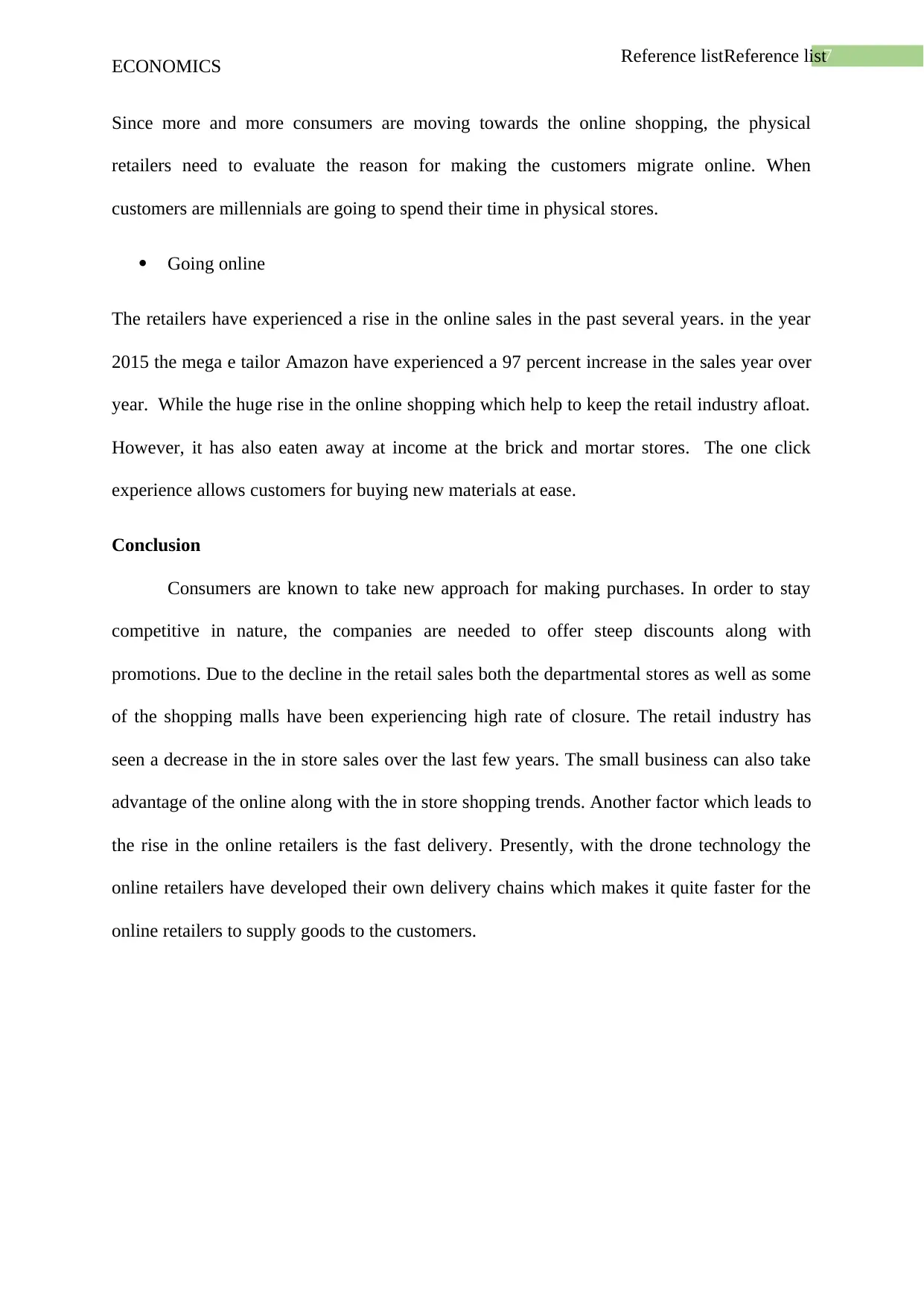
7Reference listReference list
ECONOMICS
Since more and more consumers are moving towards the online shopping, the physical
retailers need to evaluate the reason for making the customers migrate online. When
customers are millennials are going to spend their time in physical stores.
Going online
The retailers have experienced a rise in the online sales in the past several years. in the year
2015 the mega e tailor Amazon have experienced a 97 percent increase in the sales year over
year. While the huge rise in the online shopping which help to keep the retail industry afloat.
However, it has also eaten away at income at the brick and mortar stores. The one click
experience allows customers for buying new materials at ease.
Conclusion
Consumers are known to take new approach for making purchases. In order to stay
competitive in nature, the companies are needed to offer steep discounts along with
promotions. Due to the decline in the retail sales both the departmental stores as well as some
of the shopping malls have been experiencing high rate of closure. The retail industry has
seen a decrease in the in store sales over the last few years. The small business can also take
advantage of the online along with the in store shopping trends. Another factor which leads to
the rise in the online retailers is the fast delivery. Presently, with the drone technology the
online retailers have developed their own delivery chains which makes it quite faster for the
online retailers to supply goods to the customers.
ECONOMICS
Since more and more consumers are moving towards the online shopping, the physical
retailers need to evaluate the reason for making the customers migrate online. When
customers are millennials are going to spend their time in physical stores.
Going online
The retailers have experienced a rise in the online sales in the past several years. in the year
2015 the mega e tailor Amazon have experienced a 97 percent increase in the sales year over
year. While the huge rise in the online shopping which help to keep the retail industry afloat.
However, it has also eaten away at income at the brick and mortar stores. The one click
experience allows customers for buying new materials at ease.
Conclusion
Consumers are known to take new approach for making purchases. In order to stay
competitive in nature, the companies are needed to offer steep discounts along with
promotions. Due to the decline in the retail sales both the departmental stores as well as some
of the shopping malls have been experiencing high rate of closure. The retail industry has
seen a decrease in the in store sales over the last few years. The small business can also take
advantage of the online along with the in store shopping trends. Another factor which leads to
the rise in the online retailers is the fast delivery. Presently, with the drone technology the
online retailers have developed their own delivery chains which makes it quite faster for the
online retailers to supply goods to the customers.
Paraphrase This Document
Need a fresh take? Get an instant paraphrase of this document with our AI Paraphraser
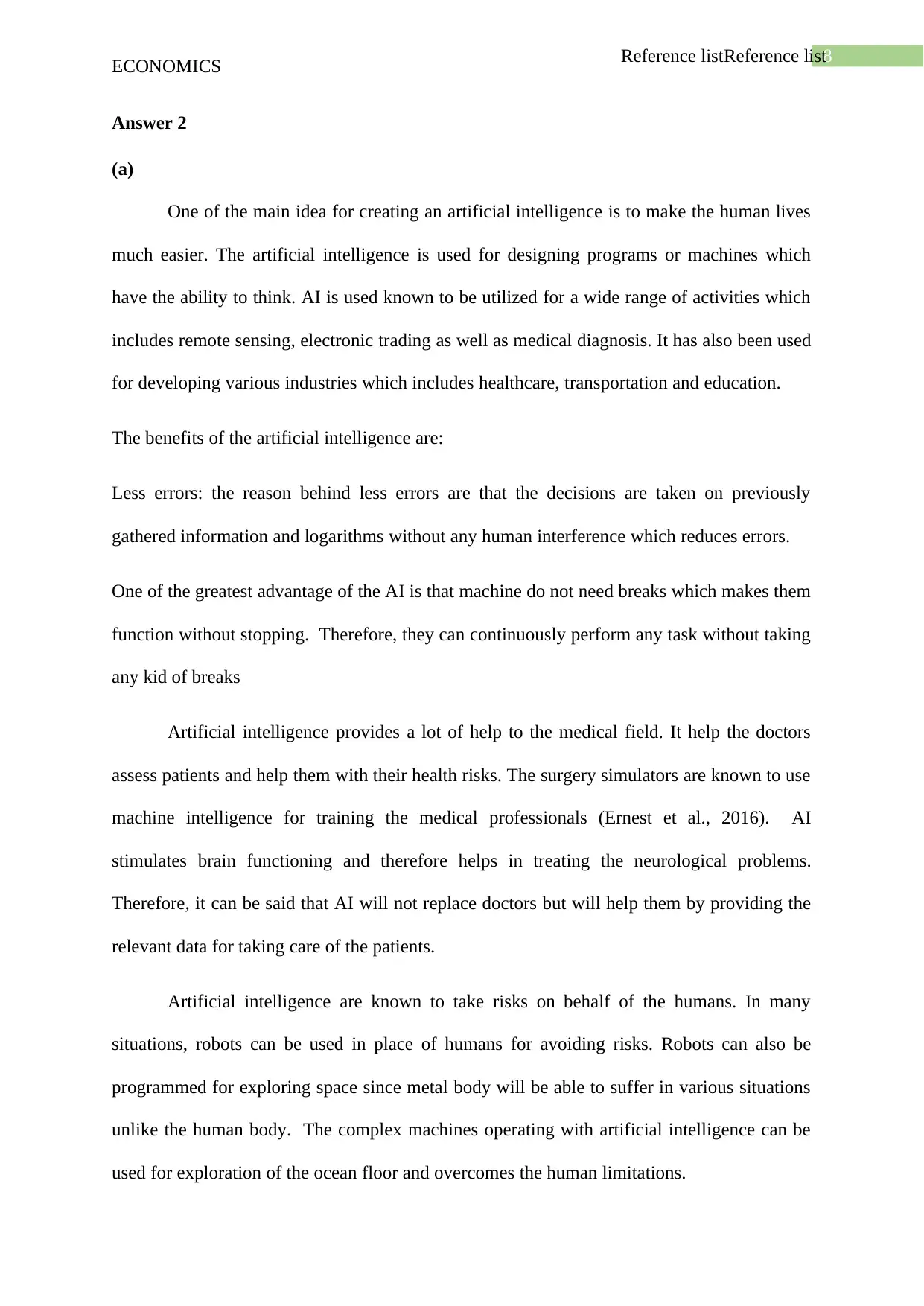
8Reference listReference list
ECONOMICS
Answer 2
(a)
One of the main idea for creating an artificial intelligence is to make the human lives
much easier. The artificial intelligence is used for designing programs or machines which
have the ability to think. AI is used known to be utilized for a wide range of activities which
includes remote sensing, electronic trading as well as medical diagnosis. It has also been used
for developing various industries which includes healthcare, transportation and education.
The benefits of the artificial intelligence are:
Less errors: the reason behind less errors are that the decisions are taken on previously
gathered information and logarithms without any human interference which reduces errors.
One of the greatest advantage of the AI is that machine do not need breaks which makes them
function without stopping. Therefore, they can continuously perform any task without taking
any kid of breaks
Artificial intelligence provides a lot of help to the medical field. It help the doctors
assess patients and help them with their health risks. The surgery simulators are known to use
machine intelligence for training the medical professionals (Ernest et al., 2016). AI
stimulates brain functioning and therefore helps in treating the neurological problems.
Therefore, it can be said that AI will not replace doctors but will help them by providing the
relevant data for taking care of the patients.
Artificial intelligence are known to take risks on behalf of the humans. In many
situations, robots can be used in place of humans for avoiding risks. Robots can also be
programmed for exploring space since metal body will be able to suffer in various situations
unlike the human body. The complex machines operating with artificial intelligence can be
used for exploration of the ocean floor and overcomes the human limitations.
ECONOMICS
Answer 2
(a)
One of the main idea for creating an artificial intelligence is to make the human lives
much easier. The artificial intelligence is used for designing programs or machines which
have the ability to think. AI is used known to be utilized for a wide range of activities which
includes remote sensing, electronic trading as well as medical diagnosis. It has also been used
for developing various industries which includes healthcare, transportation and education.
The benefits of the artificial intelligence are:
Less errors: the reason behind less errors are that the decisions are taken on previously
gathered information and logarithms without any human interference which reduces errors.
One of the greatest advantage of the AI is that machine do not need breaks which makes them
function without stopping. Therefore, they can continuously perform any task without taking
any kid of breaks
Artificial intelligence provides a lot of help to the medical field. It help the doctors
assess patients and help them with their health risks. The surgery simulators are known to use
machine intelligence for training the medical professionals (Ernest et al., 2016). AI
stimulates brain functioning and therefore helps in treating the neurological problems.
Therefore, it can be said that AI will not replace doctors but will help them by providing the
relevant data for taking care of the patients.
Artificial intelligence are known to take risks on behalf of the humans. In many
situations, robots can be used in place of humans for avoiding risks. Robots can also be
programmed for exploring space since metal body will be able to suffer in various situations
unlike the human body. The complex machines operating with artificial intelligence can be
used for exploration of the ocean floor and overcomes the human limitations.
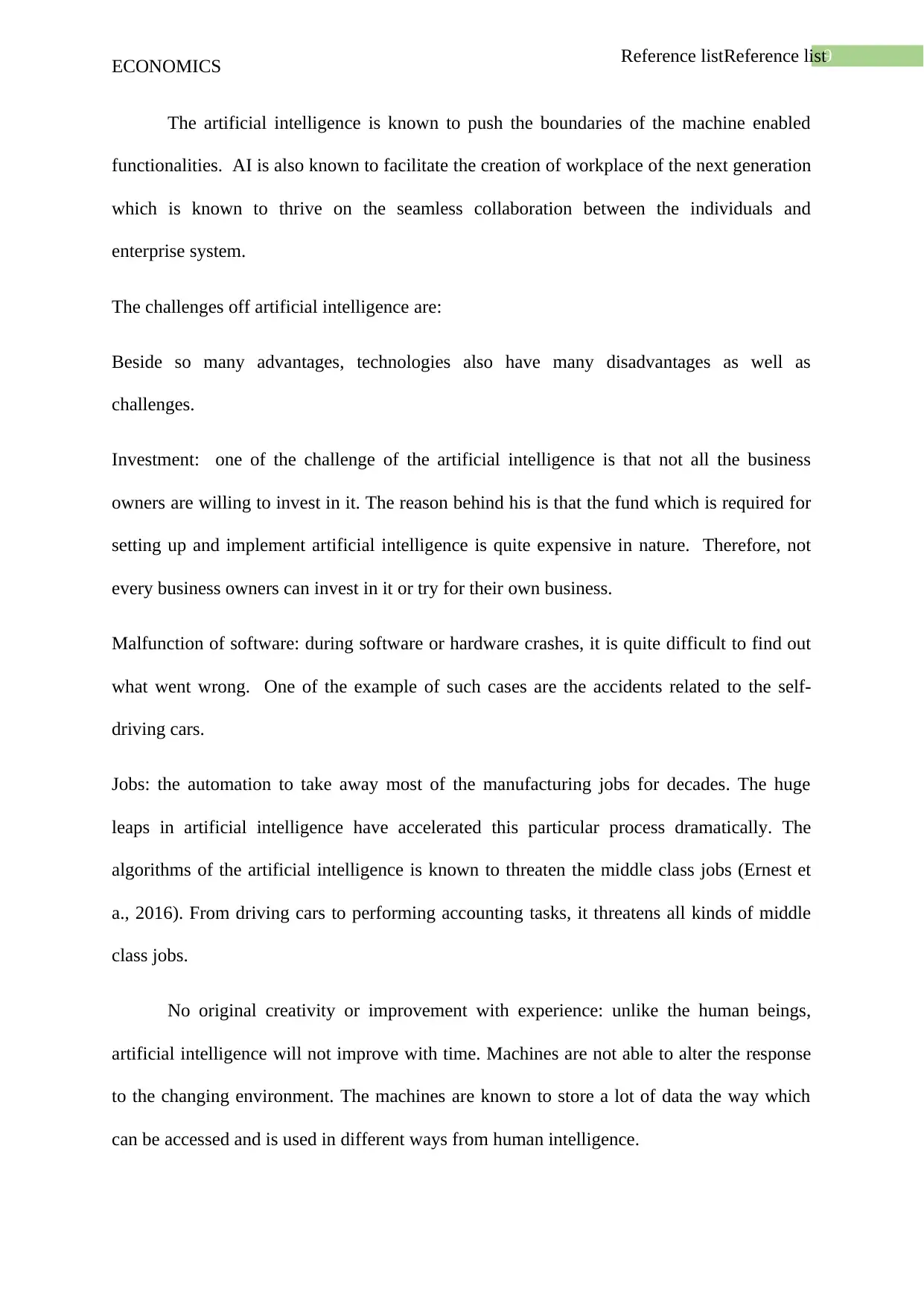
9Reference listReference list
ECONOMICS
The artificial intelligence is known to push the boundaries of the machine enabled
functionalities. AI is also known to facilitate the creation of workplace of the next generation
which is known to thrive on the seamless collaboration between the individuals and
enterprise system.
The challenges off artificial intelligence are:
Beside so many advantages, technologies also have many disadvantages as well as
challenges.
Investment: one of the challenge of the artificial intelligence is that not all the business
owners are willing to invest in it. The reason behind his is that the fund which is required for
setting up and implement artificial intelligence is quite expensive in nature. Therefore, not
every business owners can invest in it or try for their own business.
Malfunction of software: during software or hardware crashes, it is quite difficult to find out
what went wrong. One of the example of such cases are the accidents related to the self-
driving cars.
Jobs: the automation to take away most of the manufacturing jobs for decades. The huge
leaps in artificial intelligence have accelerated this particular process dramatically. The
algorithms of the artificial intelligence is known to threaten the middle class jobs (Ernest et
a., 2016). From driving cars to performing accounting tasks, it threatens all kinds of middle
class jobs.
No original creativity or improvement with experience: unlike the human beings,
artificial intelligence will not improve with time. Machines are not able to alter the response
to the changing environment. The machines are known to store a lot of data the way which
can be accessed and is used in different ways from human intelligence.
ECONOMICS
The artificial intelligence is known to push the boundaries of the machine enabled
functionalities. AI is also known to facilitate the creation of workplace of the next generation
which is known to thrive on the seamless collaboration between the individuals and
enterprise system.
The challenges off artificial intelligence are:
Beside so many advantages, technologies also have many disadvantages as well as
challenges.
Investment: one of the challenge of the artificial intelligence is that not all the business
owners are willing to invest in it. The reason behind his is that the fund which is required for
setting up and implement artificial intelligence is quite expensive in nature. Therefore, not
every business owners can invest in it or try for their own business.
Malfunction of software: during software or hardware crashes, it is quite difficult to find out
what went wrong. One of the example of such cases are the accidents related to the self-
driving cars.
Jobs: the automation to take away most of the manufacturing jobs for decades. The huge
leaps in artificial intelligence have accelerated this particular process dramatically. The
algorithms of the artificial intelligence is known to threaten the middle class jobs (Ernest et
a., 2016). From driving cars to performing accounting tasks, it threatens all kinds of middle
class jobs.
No original creativity or improvement with experience: unlike the human beings,
artificial intelligence will not improve with time. Machines are not able to alter the response
to the changing environment. The machines are known to store a lot of data the way which
can be accessed and is used in different ways from human intelligence.
⊘ This is a preview!⊘
Do you want full access?
Subscribe today to unlock all pages.

Trusted by 1+ million students worldwide
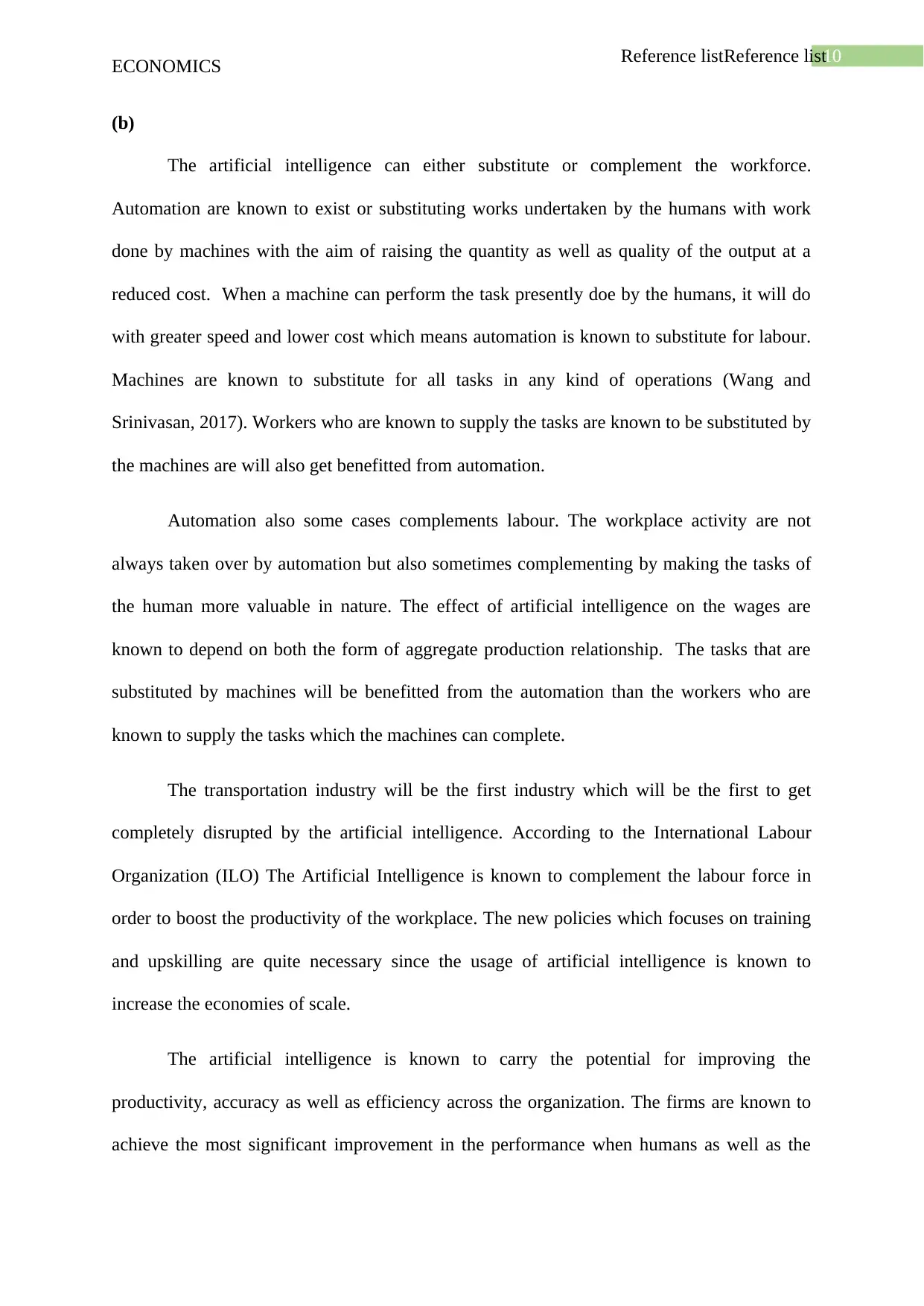
10Reference listReference list
ECONOMICS
(b)
The artificial intelligence can either substitute or complement the workforce.
Automation are known to exist or substituting works undertaken by the humans with work
done by machines with the aim of raising the quantity as well as quality of the output at a
reduced cost. When a machine can perform the task presently doe by the humans, it will do
with greater speed and lower cost which means automation is known to substitute for labour.
Machines are known to substitute for all tasks in any kind of operations (Wang and
Srinivasan, 2017). Workers who are known to supply the tasks are known to be substituted by
the machines are will also get benefitted from automation.
Automation also some cases complements labour. The workplace activity are not
always taken over by automation but also sometimes complementing by making the tasks of
the human more valuable in nature. The effect of artificial intelligence on the wages are
known to depend on both the form of aggregate production relationship. The tasks that are
substituted by machines will be benefitted from the automation than the workers who are
known to supply the tasks which the machines can complete.
The transportation industry will be the first industry which will be the first to get
completely disrupted by the artificial intelligence. According to the International Labour
Organization (ILO) The Artificial Intelligence is known to complement the labour force in
order to boost the productivity of the workplace. The new policies which focuses on training
and upskilling are quite necessary since the usage of artificial intelligence is known to
increase the economies of scale.
The artificial intelligence is known to carry the potential for improving the
productivity, accuracy as well as efficiency across the organization. The firms are known to
achieve the most significant improvement in the performance when humans as well as the
ECONOMICS
(b)
The artificial intelligence can either substitute or complement the workforce.
Automation are known to exist or substituting works undertaken by the humans with work
done by machines with the aim of raising the quantity as well as quality of the output at a
reduced cost. When a machine can perform the task presently doe by the humans, it will do
with greater speed and lower cost which means automation is known to substitute for labour.
Machines are known to substitute for all tasks in any kind of operations (Wang and
Srinivasan, 2017). Workers who are known to supply the tasks are known to be substituted by
the machines are will also get benefitted from automation.
Automation also some cases complements labour. The workplace activity are not
always taken over by automation but also sometimes complementing by making the tasks of
the human more valuable in nature. The effect of artificial intelligence on the wages are
known to depend on both the form of aggregate production relationship. The tasks that are
substituted by machines will be benefitted from the automation than the workers who are
known to supply the tasks which the machines can complete.
The transportation industry will be the first industry which will be the first to get
completely disrupted by the artificial intelligence. According to the International Labour
Organization (ILO) The Artificial Intelligence is known to complement the labour force in
order to boost the productivity of the workplace. The new policies which focuses on training
and upskilling are quite necessary since the usage of artificial intelligence is known to
increase the economies of scale.
The artificial intelligence is known to carry the potential for improving the
productivity, accuracy as well as efficiency across the organization. The firms are known to
achieve the most significant improvement in the performance when humans as well as the
Paraphrase This Document
Need a fresh take? Get an instant paraphrase of this document with our AI Paraphraser
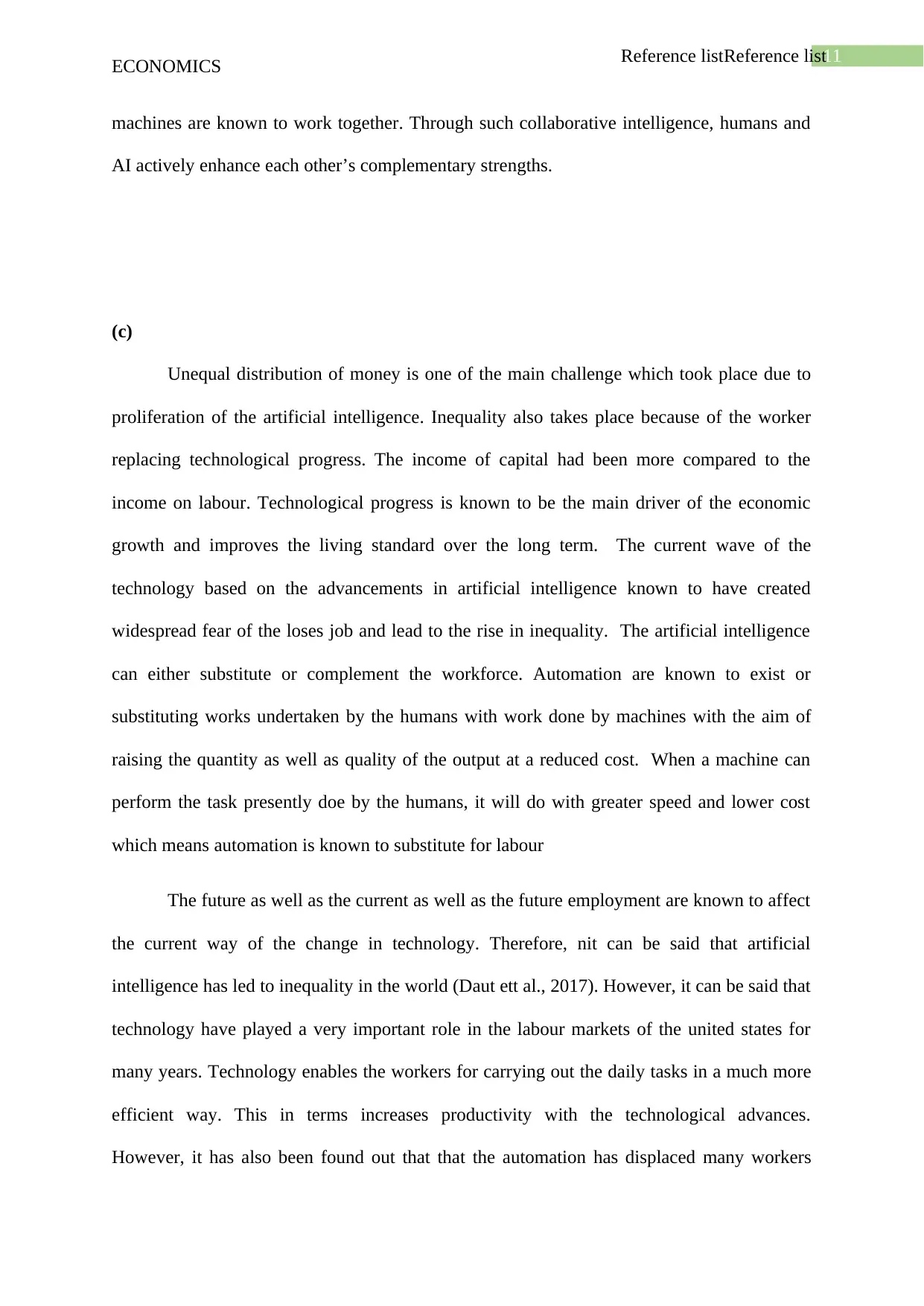
11Reference listReference list
ECONOMICS
machines are known to work together. Through such collaborative intelligence, humans and
AI actively enhance each other’s complementary strengths.
(c)
Unequal distribution of money is one of the main challenge which took place due to
proliferation of the artificial intelligence. Inequality also takes place because of the worker
replacing technological progress. The income of capital had been more compared to the
income on labour. Technological progress is known to be the main driver of the economic
growth and improves the living standard over the long term. The current wave of the
technology based on the advancements in artificial intelligence known to have created
widespread fear of the loses job and lead to the rise in inequality. The artificial intelligence
can either substitute or complement the workforce. Automation are known to exist or
substituting works undertaken by the humans with work done by machines with the aim of
raising the quantity as well as quality of the output at a reduced cost. When a machine can
perform the task presently doe by the humans, it will do with greater speed and lower cost
which means automation is known to substitute for labour
The future as well as the current as well as the future employment are known to affect
the current way of the change in technology. Therefore, nit can be said that artificial
intelligence has led to inequality in the world (Daut ett al., 2017). However, it can be said that
technology have played a very important role in the labour markets of the united states for
many years. Technology enables the workers for carrying out the daily tasks in a much more
efficient way. This in terms increases productivity with the technological advances.
However, it has also been found out that that the automation has displaced many workers
ECONOMICS
machines are known to work together. Through such collaborative intelligence, humans and
AI actively enhance each other’s complementary strengths.
(c)
Unequal distribution of money is one of the main challenge which took place due to
proliferation of the artificial intelligence. Inequality also takes place because of the worker
replacing technological progress. The income of capital had been more compared to the
income on labour. Technological progress is known to be the main driver of the economic
growth and improves the living standard over the long term. The current wave of the
technology based on the advancements in artificial intelligence known to have created
widespread fear of the loses job and lead to the rise in inequality. The artificial intelligence
can either substitute or complement the workforce. Automation are known to exist or
substituting works undertaken by the humans with work done by machines with the aim of
raising the quantity as well as quality of the output at a reduced cost. When a machine can
perform the task presently doe by the humans, it will do with greater speed and lower cost
which means automation is known to substitute for labour
The future as well as the current as well as the future employment are known to affect
the current way of the change in technology. Therefore, nit can be said that artificial
intelligence has led to inequality in the world (Daut ett al., 2017). However, it can be said that
technology have played a very important role in the labour markets of the united states for
many years. Technology enables the workers for carrying out the daily tasks in a much more
efficient way. This in terms increases productivity with the technological advances.
However, it has also been found out that that the automation has displaced many workers
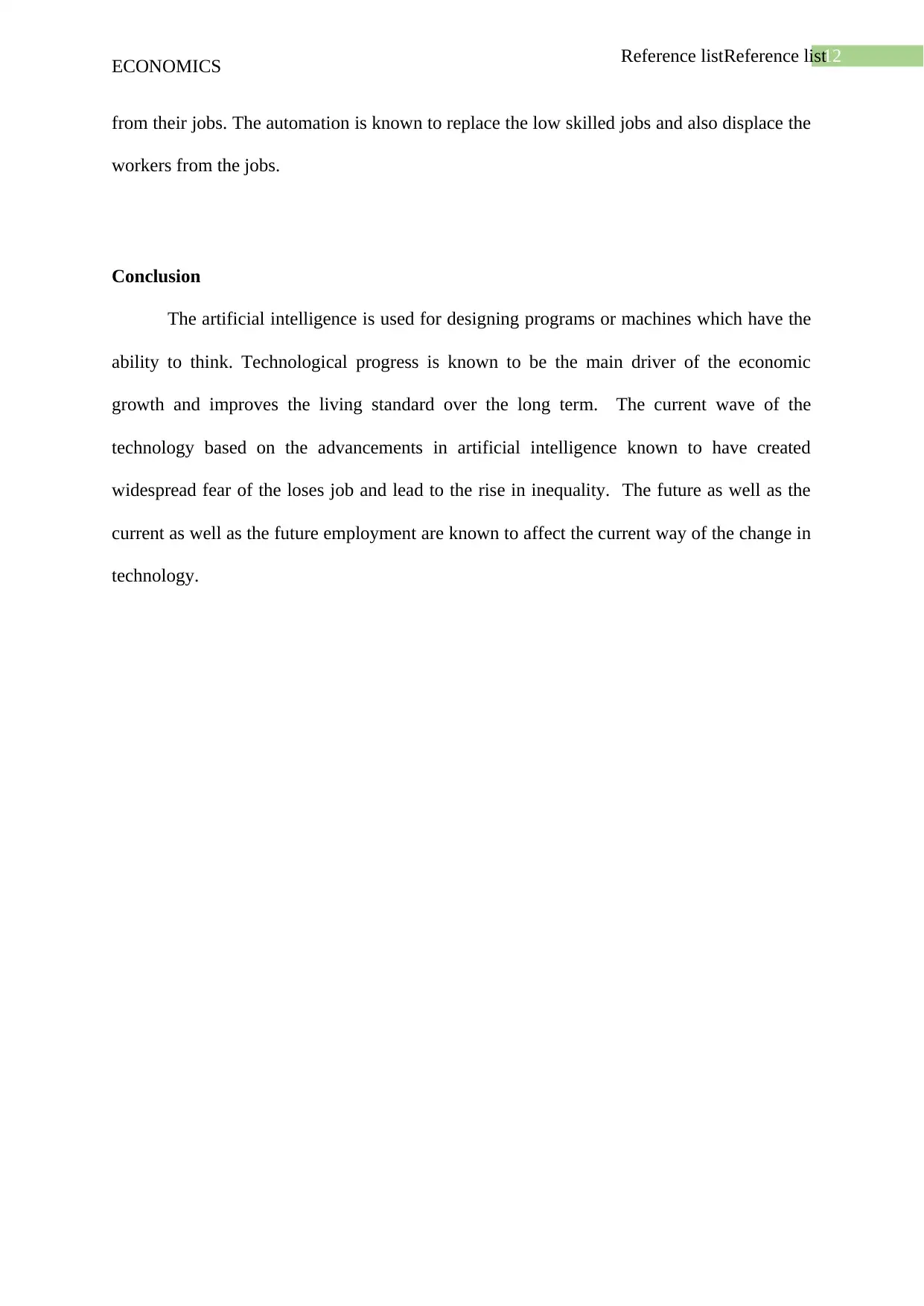
12Reference listReference list
ECONOMICS
from their jobs. The automation is known to replace the low skilled jobs and also displace the
workers from the jobs.
Conclusion
The artificial intelligence is used for designing programs or machines which have the
ability to think. Technological progress is known to be the main driver of the economic
growth and improves the living standard over the long term. The current wave of the
technology based on the advancements in artificial intelligence known to have created
widespread fear of the loses job and lead to the rise in inequality. The future as well as the
current as well as the future employment are known to affect the current way of the change in
technology.
ECONOMICS
from their jobs. The automation is known to replace the low skilled jobs and also displace the
workers from the jobs.
Conclusion
The artificial intelligence is used for designing programs or machines which have the
ability to think. Technological progress is known to be the main driver of the economic
growth and improves the living standard over the long term. The current wave of the
technology based on the advancements in artificial intelligence known to have created
widespread fear of the loses job and lead to the rise in inequality. The future as well as the
current as well as the future employment are known to affect the current way of the change in
technology.
⊘ This is a preview!⊘
Do you want full access?
Subscribe today to unlock all pages.

Trusted by 1+ million students worldwide
1 out of 16
Related Documents
Your All-in-One AI-Powered Toolkit for Academic Success.
+13062052269
info@desklib.com
Available 24*7 on WhatsApp / Email
![[object Object]](/_next/static/media/star-bottom.7253800d.svg)
Unlock your academic potential
Copyright © 2020–2025 A2Z Services. All Rights Reserved. Developed and managed by ZUCOL.




